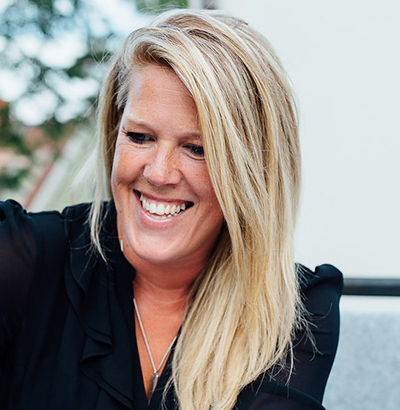
Sonya Simmonds is an interior architect and workplace strategist with over 20 years of experience in international office design for companies such as Schroders, Bloomberg, Discovery Channel, and DICE EA Games, with a strong focus on inclusive, sustainable, and experiential design.
Based in Stockholm, Sweden, Sonya has worked at Spotify for the last four years in varying roles – Global Head of Distributed Experience, Head of Innovation and Design, and Head of Design and Build. Defining and executing the design strategy for the Spotify workplace portfolio has been her main work in an architectural capacity, creating new and transforming existing offices globally into award-winning workplaces.
Sonya has frequently spoken publicly on panels, describing how to apply workplace design strategies, including reworking processes for design and construction, creating holistic global (but local) design standards as well as the applicable of new technologies to the built environment.
Sonya is a keen mentor to architectural students, has been a judge for design awards, and is often featured in articles and books about the workplace and the future of the workplace.
Sonya Simmonds
We recently caught up with Sonya, after she completed our program on AI, Machine Learning, & The Built Environment to hear her perspective on the programs and the current state of the global workplace.
Why did you choose to sign up for this program and how was your experience?
I chose the course because I knew it would be of good quality and I am always seeking to learn and understand what comes next so that I’m be able to discuss AI / ML in terms of what it means for real estate & architecture.
This course was very clear on what it would offer, and what I was happy and surprised with was how honest the discussion was around which problems AI and ML are well-suited to solve or less likely to solve.
The quality of information and the sequence was easy to follow and the examples gave great depth to the concepts.
Has your view on AI and Machine Learning in the built environment changed because of this program?
It has shown me what could be possible, the best applications of ML and after the course I am more convinced that over the next 10 years, Machine Learning has the potential to be hugely advantageous for architects, real estate, and workplace development.
This base understanding of AI and more specifically Machine Learning learned in this program, combined with a guide of what problems ML is most likely to solve, are helpful in terms of being able to evaluate what is offered on the market and whether it is useful.
You have worked at Spotify as “Head of Distributed Experience”, having previously served as the Head of Design & Build and Head of Innovation & Design. How has your role changed in recent years?
Even before 2020, many large companies were already distributed just by their nature of having globally distributed locations. In my Design & Build role, I was responsible for creating offices and studios for Spotify employees – working globally on the entire build process from due diligence through to design to construction.
In recent years, the biggest change globally is the choice that most people have to work both in the office and at home which has had implications on capacity planning and building use, as well as changing needs and wanted experiences in the workplace. Globally, most companies are now figuring out what makes their workplaces truly purposeful and how to optimize for productivity and profitability.
Gathering and correlating data to enable better decision making in projects within the ‘built environment’ has become essential and more available. With the development of ML and application of data models, I hope to explore solutions that will help make projects more cost and time efficient, better informed and more sustainable, ultimately impacting how workplaces evolve. This course has been the start of that journey.
